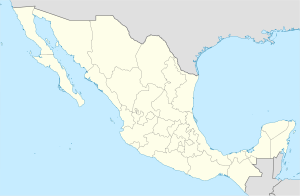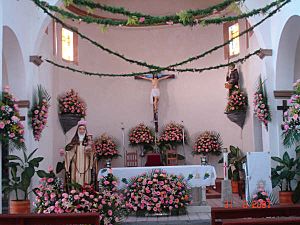Los Otates facts for kids
Quick facts for kids
Otates
|
||
|---|---|---|
|
Town
|
||
| Los Otates | ||
|
||
| Country | ||
| State | ||
| Founded | 1743 | |
| Elevation | 540 m (1,770 ft) | |
| Population
(2009 estimate)
|
||
| • Total | 1,608 | |
| Time zone | UTC-6 (Central Standard Time) | |
| • Summer (DST) | UTC-5 | |
Los Otates is a town in Mexico, located in the state of Veracruz. It's part of the Actopan municipality.
Contents
- Discovering Los Otates: Location and Life
- A Journey Through Time: The History of Los Otates
- Faith and Festivities: Religion in Los Otates
- Learning and Development: Education in Los Otates
- Community Services: Other Facilities
- Exploring Nature: Tourist Attractions
- Farming Life: Agriculture in Los Otates
- Wildlife Wonders: Flora and Fauna
- See also
Discovering Los Otates: Location and Life
Los Otates is found in the central part of Veracruz state. It sits 540 meters (about 1,770 feet) above sea level. In 2006, about 1,174 people lived here. Most people in Los Otates are Catholic.
The town has many important public services for its residents. These include clean drinking water and street lights. There is also garbage collection and paved roads. Los Otates has a health center and a church. You can find a library and cell phone service too. Public transport, schools, and fun recreation areas are also available.
A Journey Through Time: The History of Los Otates
Ancient Roots: Totonac People
Long ago, the area of Los Otates was home to the Totonacas. Scientists have found old items in a place called La Capilla. These items include pottery made of ceramic and tools made from obsidian stone.
Colonial Times: Ranches and Changes
In 1579, a person from Xalapa asked to buy land for cattle. This land was in the areas of Chicu, Actopan, and Atexcan. By 1600, this ranch was given to Paul Gutierrez. Later, it was owned by Don Roque de Cevallos Gutierrez. His family faced many problems. They had debts, dry weather, and diseases. Many people and animals died.
In 1692, a court took over the property. It then went to nuns in Puebla. That same year, Don Francisco Dominguez Muniz bought the land. He used it for livestock and called it Cañada de los Otates.
The Dominguez family kept the land for many years. Later, Francisco Dominguez's grandchildren divided it. One grandchild, Catarina de la Oliva Dominguez, gave her share to the people who worked on the estate.
Some of the first families had Spanish last names like Palmeros and Barradas. Later, other families arrived. These included Salazar, Rodriguez, Ávila, and Lopez. These families still live in Los Otates today.
Modern Era: Land Ownership and Growth
Around 1899, the government took control of the land. They gave Los Otates to Don Ortega Crescencio. After he passed away, the people of the town bought the land from his wife. Don Juan Barradas, José Salazar, and Don Jose de la Paz Avila helped gather the money.
Faith and Festivities: Religion in Los Otates
The first church in Los Otates was built in 1766. It looked like a small wooden building. It also has the oldest bell in the town.
Later, a new concrete chapel was built. The church tower was added in 1879. It was made bigger in 1945 and 1946. The domes were also built then. In 1973, Santa Rosa de Lima became the church's patron saint.
In the early 1990s, the church was updated. Its original front part was kept. The priest from Otates also served other nearby communities.
Every year on August 30, a special celebration takes place. It honors Santa Rosa de Lima, the town's patron saint. This day also celebrates the land that Catarina de la Oliva Dominguez gave to the people.
Another popular celebration is on November 13. This is the feast of bread, honoring San Diego de Alcalá. Many people prepare and share large amounts of bread with their families and friends.
Learning and Development: Education in Los Otates
The first school in Los Otates was built around 1870. It served the community for a long time. In 1973, a new elementary school classroom was built. Its first students finished in 1976.
A high school opened in 1977. Its construction began in 1974. In 1975, a college-prep program started. It was in a temporary building that used to be a public laundry.
The Otates Public Library was created in 1977. It sometimes offered classes in skills like sewing, baking, and fruit growing. A kindergarten started in 1983. Its building was officially opened on September 19, 1985.
In 2006, the college-prep program moved. It is now in a school building near the secondary school.
Community Services: Other Facilities
The town's cemetery was built around 1970. The health center, which helps people stay well, was built in 1976.
Exploring Nature: Tourist Attractions
The Descabezadero: River Source Adventure
This is where the Actopan river begins. It's a beautiful spot with lots of plants and animals. The river flows over a tall cliff here. Visitors can go rafting and abseiling (rappelling) down the cliff. The river eventually flows into the Gulf of Mexico at Chachalacas.
Poza Azul: The Blue Water Lake
Poza Azul is a "lake" with very clear blue water. A small river flows from it. This river connects to the Actopan River about 1.5 kilometers (about 1 mile) downstream.
The Chapel: A Mountain Landmark
The Chapel is located on a mountain near Los Otates. Its first stone was laid on November 1, 1902. It was finished in 1907. Around 1945, a fire damaged its wooden parts and roof. During rebuilding, the chapel was made larger. It was built to be a school run by missionaries. However, the missionaries left during a revolution and did not return.
Farming Life: Agriculture in Los Otates
Farming in Los Otates mainly focuses on mango and chayote (also called christophene). These crops are sold within Mexico and sent to other countries. Other crops like tomatoes, maize (corn), beans, and sugarcane are also grown, but in smaller amounts.
When you drive into Los Otates, you can see large fields. These fields are filled with all sorts of crops.
Wildlife Wonders: Flora and Fauna
Los Otates has many different kinds of plants. You can find "Patancan" cactus, "nacasle," acacia, tamarisk, and mango trees. There are also valuable woods like cedar and mahogany. Various types of mangroves grow here too.
The area is home to many birds. These include quail, calandria, torcacita, owls, zopilotes, palomas, chachalacas, and sparrowhawks.
There is also a wide variety of wild animals. You might see different kinds of snakes, like the bell snake and the coral snake. There are many rabbits, raccoons, false coral snakes, nauyaca snakes, lizards, and iguanas.
See also
 In Spanish: Los Otates para niños
In Spanish: Los Otates para niños





